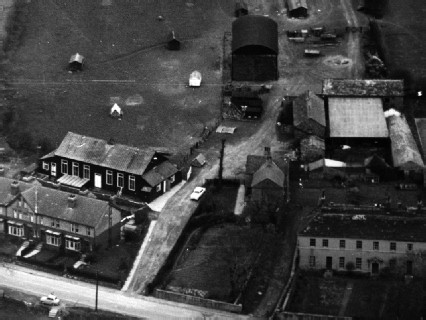
Scholes Village Hall - Sunday, 26 March 1967.
©Skyviews archives
| President - Herbert Miers Gray of Morwick Hall |
| Chairman - Frederick Kitchen |
| Secretary - Ernest Boyce. |
| Treasurer - Samuel Myers. |
| For the (possible) use as a school by the West Riding County Council, an inclusive annual rental of £100 was to be charged. | |
| General Functions: | 2.00 to 5.00pm - a sum of 7s.6d. 6.30pm until midnight - £1.1s.0d. and 5s.0d for every hour after midnight |
| Main Hall only | 6.30 to 11.0.pm - 15s.0d. |
| Small Room. | 2.00pm to 5.00pm - 3s.6d.(5s.0d. if using crockery) 6.30 to 11.0pm - 5s.0d. |
| Badminton | 10s.0d.for one night (6.30pm to 10.30pm). 15s.0d. for two nights |
| Total cost of the Hall for the purpose of 'the Fund' | £880. |
| Raised locally in cash towards this : | £584 |
| - leaving to be found | £296 |
| Loan from the National Council | £150 |
| Grant from the Carnegie Trustees | £150 |
| Men's Conservative Association Women's Conservative Assocn. Scholes Church Council Scholes Chapel Trust Scholes Cricket Club Arthursdale Cricket Club. Scholes British Legion Scholes Badminton Club Scholes Tennis Club Garth Tennis Club Scholes Village Players Boy Scouts and Girl Guides Scholes Football Club Scholes Church Men's Club Scholes Women's Institute Scholes Private Golf Elmete Badminton Club Fellowship Club |
| Village Hall Committee regular Saturday
night dances The long-running Scholes Village Players and Green Room Club. Scholes Horticultural Society Annual Exhibition Good Companions Socials. Scottish Dancing Classes. Ladies Whist Club. Leeds District Young Farmers. Women's Keep Fit. Parent Teachers. |
| Total expenditure year ending 31/12/1933 | £259.18s.1d. | |
| including Gas, Electricity and Water rate | £25.11s.4d. | |
| and Insurance | £5.15s.10d. | |
| Total 2002 to 2003 Accounts | £13,370.21 | |
| including Gas, Electric and Water rates | £1,686.14 | |
| Insurance | £1,485.60 | |